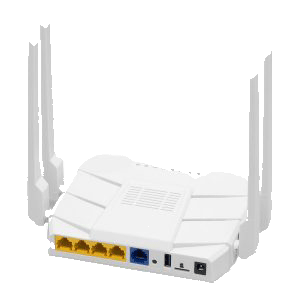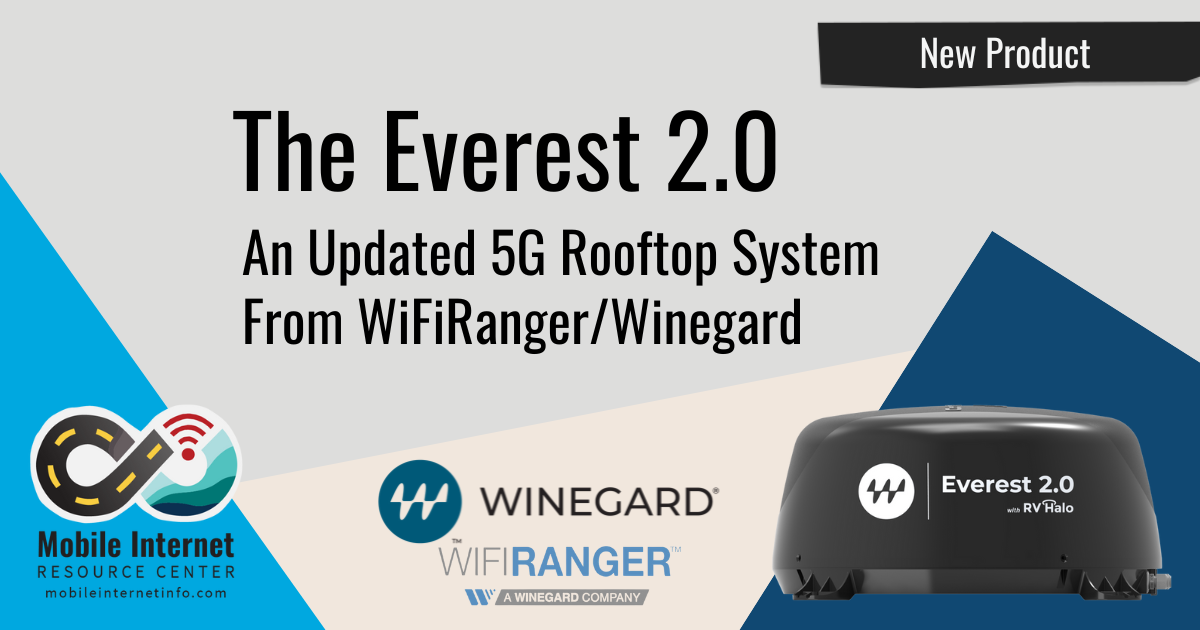Key Points:
- Winegard released an "Everest 2.0" rooftop unit with several major changes from the original WiFiRanger Everest.
- The Everest 2.0 now comes with an embedded X62 modem and is certified on AT&T and T-Mobile with Verizon certification coming soon.
- The "Converge" sharkfin form factor is now gone, replaced by the familiar dome used in Winegard's ConnecT and Air360+ systems.
- The Everest 2.0 is currently sold in a "pack" for $999, including an indoor WiFiRanger Aspen router with a Cat-12 LTE modem, providing dual-modem capability.
 Winegard, which acquired WiFiRanger back in 2020, is out with a new model of the Everest rooftop connectivity system, called the Everest 2.0. While the WiFiRanger lineage is still there, the branding is now exclusively Winegard, and the Everest 2.0 represents a product that fuses the features and technology of both Winegard and WiFiRanger.
Winegard, which acquired WiFiRanger back in 2020, is out with a new model of the Everest rooftop connectivity system, called the Everest 2.0. While the WiFiRanger lineage is still there, the branding is now exclusively Winegard, and the Everest 2.0 represents a product that fuses the features and technology of both Winegard and WiFiRanger.
The Everest 2.0 is sold as a kit with an Aspen LTE Cat-12 indoor router to provide a complete dual-cellular connectivity package for $999. This new model replaces the existing Winegard/WiFiRanger Converge line.
The biggest changes include a new dome form factor, a 5G modem upgrade to a more advanced X62 model, and other adjustments that make the Everest 2.0 much more than an iterative evolution of the original Everest.
Let's dig into the details to see everything that is new or changed with the Everest 2.0...
Table of Contents
New Everest 2.0 Video Overview
Everest 2.0 5G Specifications
The Everest 2.0 is Winegard's flagship outdoor router and is a new design that combines Winegard and WiFiRanger technology.
Like the previous Everest, the 2.0 model is designed to provide multiple connectivity options - long-range dual-band 2.4 GHz and 5 GHz Wi-Fi capabilities and integrated 5G cellular, all in an integrated rooftop system, which minimizes signal loss for both cellular and Wi-Fi.
There are no long antenna cable runs, minimizing signal loss.
The Everest 2.0 kit is paired with an indoor Aspen router via an Ethernet cable. The WiFiRanger firmware allows the Aspen to manage the Everest 2.0 on the roof and operate both the indoor and outdoor routers with a common interface.
New Form Factor
The biggest visual change with the new Everest 2.0 system is that the sharkfin design for the previous Everest and other WiFiRanger Converge outdoor routers is gone, replaced with essentially the same dome used in the Winegard ConnecT 2.0.
The cellular and Wi-Fi antennas, along with the router, are all housed in the dome like the ConnecT 2.0. A power and Ethernet cable come out of the side, and there is a cover over the two SIM card slots, just like the ConnecT 2.0, allowing access without removing the dome.
In some ways, this new form factor is an improvement over the Converge design, notably much easier access to the SIM card slots. The dome is also about an inch shorter than the Converge sharkfin, but otherwise, it has a larger footprint.
On the performance side, the larger form factor allows room for larger antennas and greater distance between the antenna elements, which is good for MIMO signal diversity and preventing interference.
The Everest 2.0 does NOT include an over-the-air TV/Radio antenna like some models of the ConnecT 2.0 and Air360+ systems do.
Everest 2.0 5G Cellular Modem
The most important new development of Everest 2.0 is the cellular modem, which is finally a more modern X62 design than the X55 in the previous 5G Everest.
X62 routers have been out for a couple of years now, and it's the minimum 5G modem we recommend for 5G devices. While it's been disappointing that it's taken Winegard so long, it's nice to finally see this as an option.
For band coverage, the Everest 2.0 covers almost all 5G and LTE bands in use today, lacking only band 48/n48:
- 5G Bands: n1, n2, n3, n5, n7, n8, n12, n20, n25, n28, n38, n40, n41, n66, n71, n77, n78, n79
- LTE Bands: 1, 2, 3, 4, 5, 7, 8, 12, 13, 14, 17, 18, 19, 20, 25, 26, 28, 29, 30, 32, 34, 38, 39, 40, 41, 42, 43, 66, 71
Additionally, Winegard tells us that Everest 2.0 is certified by T-Mobile and AT&T with Verizon certification coming soon. This should make it much easier to activate the Everest 2.0 directly on a major carrier cellular plan. Winegard also offers plan options for its products from the three major carriers.
Winegard And WiFiRanger Firmware
With the acquisition of WiFiRanger in 2020, Winegard products use two different firmware systems with different features, capabilities, and limitations—Winegard's own newly-revamped Connect OS system and the existing WiFiRanger firmware, which is still technically in beta (but stable) and hasn't received a major update in some time. The Everest 2.0 continues to use WiFiRanger firmware, at least until Winegard is finally able to merge the two.
Winegard plans to eventually merge the capabilities and features of the WiFiRanger firmware with those of Winegard's Connect OS firmware. But it's not clear when that will be achieved, and with Winegard now branding all products, including the new Everest 2.0, the different firmware can cause some consumer confusion.
For example, the Winegard smart RV system of Bluetooth sensors is not currently compatible with the WiFiRanger firmware, although Winegard is working on adding that capability.
Members can read all the details and analysis of the separate firmware in our product lineup where we have a Deep Dive going into each.
The Everest 2.0 Kit
Winegard is selling the Everest 2.0 only as a kit with the Aspen indoor router for $999. This is the same price as the previous X55 Everest kit that came with a Spruce router. The Aspen comes with a Cat-12 LTE modem, providing a second cellular option. So, it's nice to see the price did not go up for a significant bump in capability and performance.

At press time, the Everest 2.0 isn't available standalone, and it's unclear when and if that option will be offered in the future. Additionally, other models in WiFiRanger's Converge lineup, like the Denali, are not currently available, but we would not be surprised to see them move to this new form-factor.
Winegard is also heavily integrated into the OEM market, and the new Everest uses the same dome as the ConnecT 2.0. Therefore, we would not be surprised to see variants of this new system appear preinstalled on new RVs in the future—which would be a good thing because the Cat-4 modem in the ConnecT 2.0 becomes more obsolete each passing year.
Member Exclusive Analysis
Bonus Member Only Content Available!
We go extra for our premium members - who make this resource center possible (did you notice the lack of 3rd Party advertising?). We have included some additional information in this news article just for our members - analysis, guidance and/or insider tips.
If you're not yet a member, please consider joining us. Extra content like this is one of the many perks we offer - in-depth content, guidance, discounts, alerts, classroom and more.

If you are already a member, please log in above to see the special content we have prepared for you.
Concluding Thoughts
With the Winegard Everest 2.0, the WiFiRanger brand seems officially dead, but its technology and features live on. The Everest 2.0 significantly differs from the previous Everest models in several important aspects and represents a further integration of Winegard and WiFiRanger products toward eventual unity.
Winegard/WiFiRanger is last to the party in offering a product with a modern X62 5G modem with the Everest 2.0, but it's great they finally got here. This aspect alone makes the Everest 2.0 worth considering for those looking for a rooftop package, especially those who value long-range Wi-Fi-as-WAN. The Everest 2.0 kit also comes with an indoor router that provides a second LTE Cat-12 cellular modem and the ability to integrate Starlink, USB, and other Ethernet & WiFi WAN connections, providing a potential plethora of multi-WAN connectivity options.
For more information:
Related MIRC Content
- Guide: Selecting Mobile Routers
- Gear Center: WiFiRanger/Winegard Outdoor Routers
- Gear Center: WiFiRanger/Winegard Aspen Indoor Router
Related News Stories:










 Mobile Internet Resource Center (dba Two Steps Beyond LLC) is founded by Chris & Cherie of
Mobile Internet Resource Center (dba Two Steps Beyond LLC) is founded by Chris & Cherie of